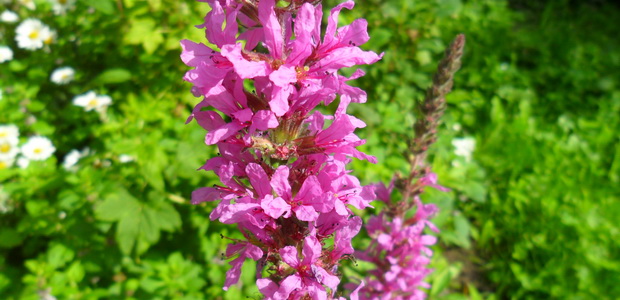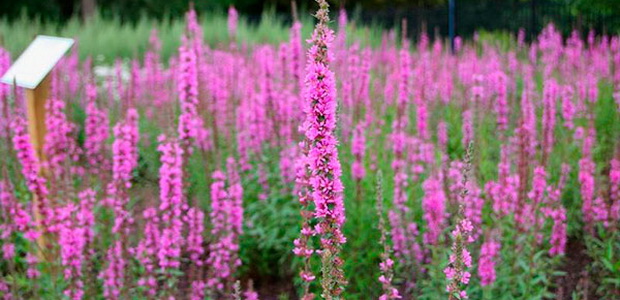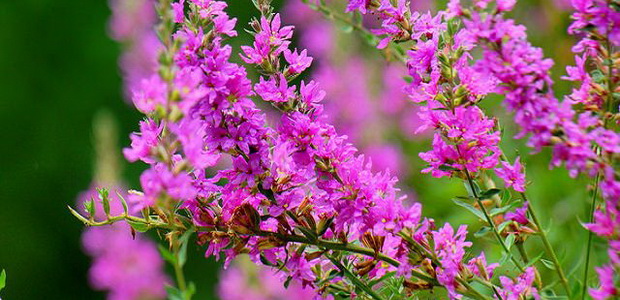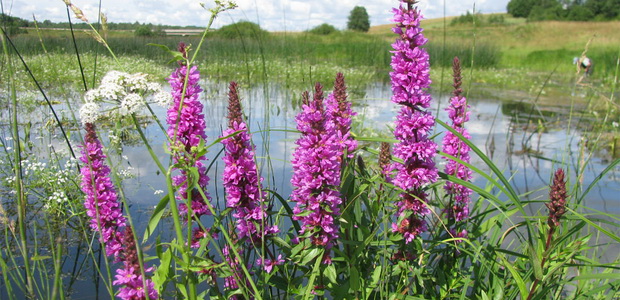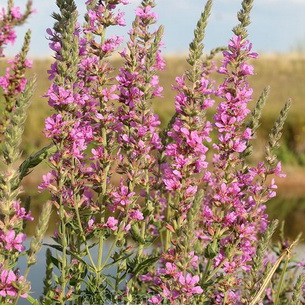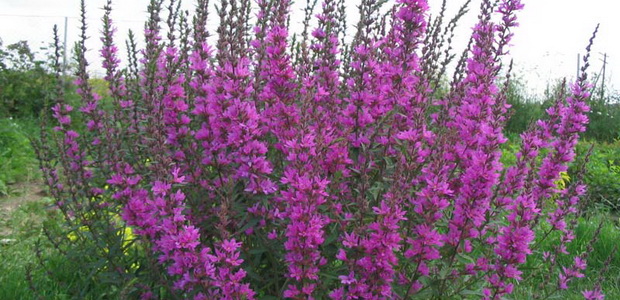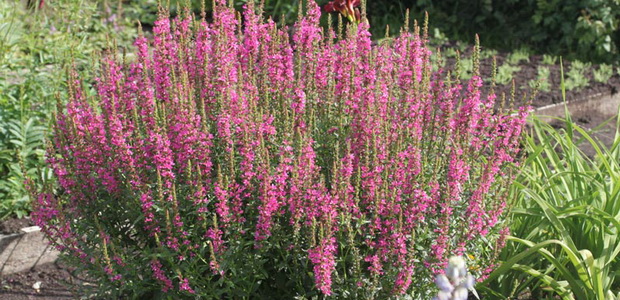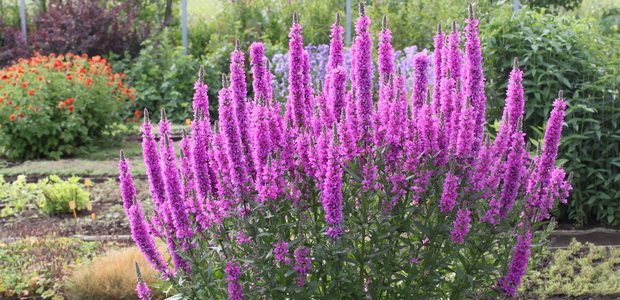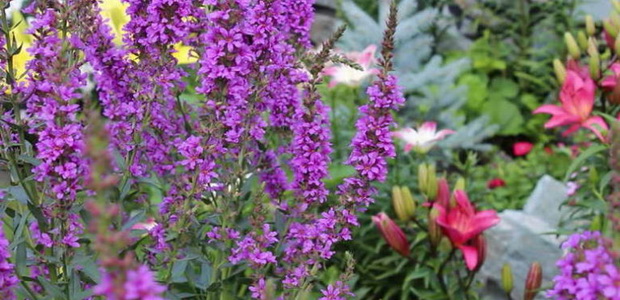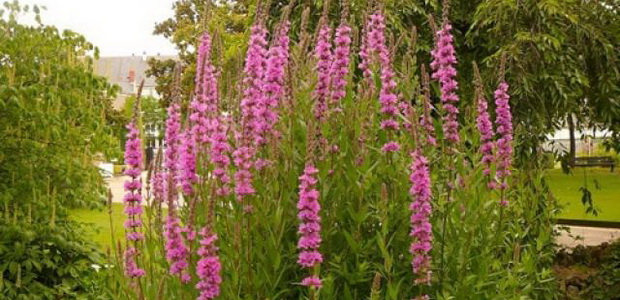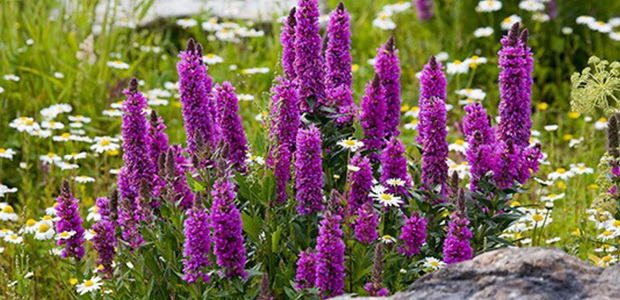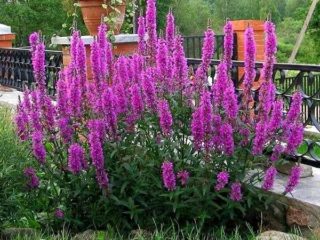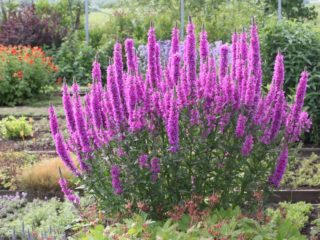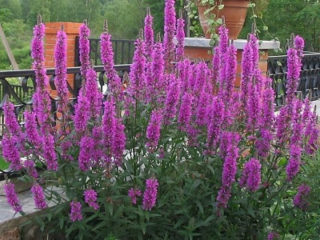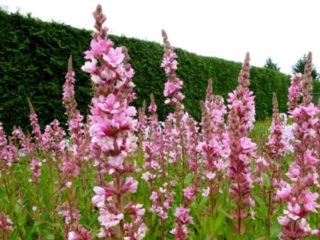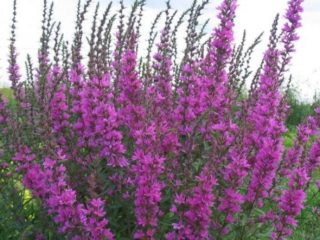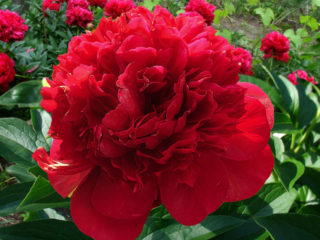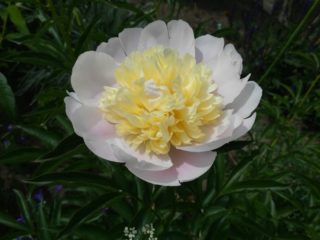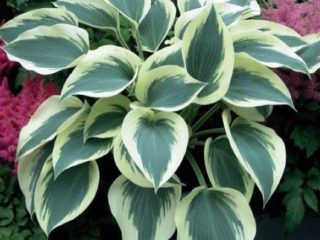Content
Planting and caring for loosestrife is classic and does not feature complex agricultural technology. This representative of the flora is a beautiful herbaceous perennial of the Derbennikov family. The name of the plant comes from the Greek word "lytron", which means "coagulated, shed blood." It is distributed on all continents except desert and tropical regions. In its natural habitat, the ornamental crop grows in swamps, in coastal areas of rivers, in flooded rice fields, and flooded meadows.
On hot summer days, drops of water form on the leaves of the merlin. According to one beautiful legend, transparent dewdrops are the tears of the Virgin Mary for her son.In fact, this phenomenon has a scientific explanation: as a result of the work of special stomata located on the back of the leaves, excess accumulated moisture is removed from the plant.
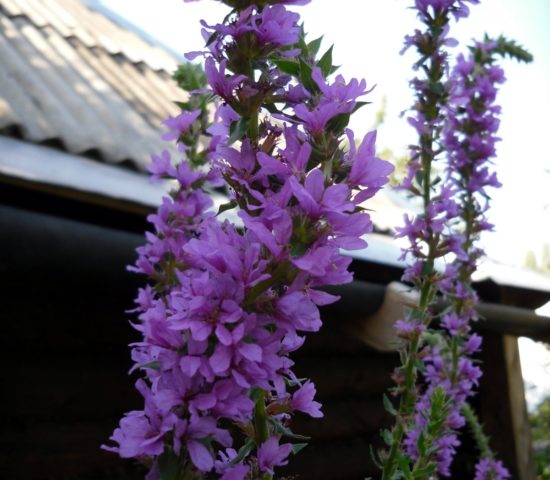
Commonly, loosestrife is called “swamp candles”, “God’s grass”, “podberezhnik”, “grandfather’s grass”, “hog reed”, “plakun-root”, “plakun-grass”
Description of the loosestrife
Various types of loosestrife differ in common characteristics:
- the root system is creeping, superficial, woody;
- stems are straight, elastic, dense, tetrahedral;
- stem height up to 1.5 m;
- leaf blades are lanceolate, petiolate, with a point at the apex, with stomata on the back side;
- leaf color is bright green or dark green;
- leaf length up to 10 cm;
- inflorescences whorled or spike-shaped;
- inflorescence length up to 50 cm;
- flower shape is star-shaped, six-petaled;
- flower diameter up to 1 cm;
- the color of the flower petals is pink, bright crimson, lilac, violet;
- fruits are round, elongated capsules.
Descriptions of loosestrife and photos of plants allow us to draw conclusions about the degree of decorativeness of garden crops.
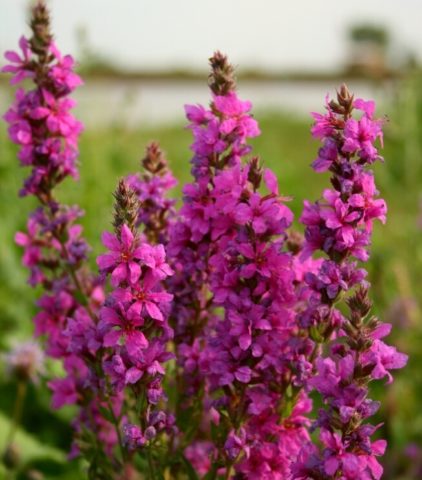
The height of some weeping grass bushes reaches 1.8-1.9 m
When and how does the loosestrife bloom?
Flowering of loosestrife (plakun-grass) begins in June and continues until the end of August or beginning of September.
The buds are densely located on spike-shaped inflorescences. From June, small flowers begin to bloom one by one, gradually coloring the tall peduncles. Budding continues until September inclusive. Merlin blooms most profusely on moist soils.
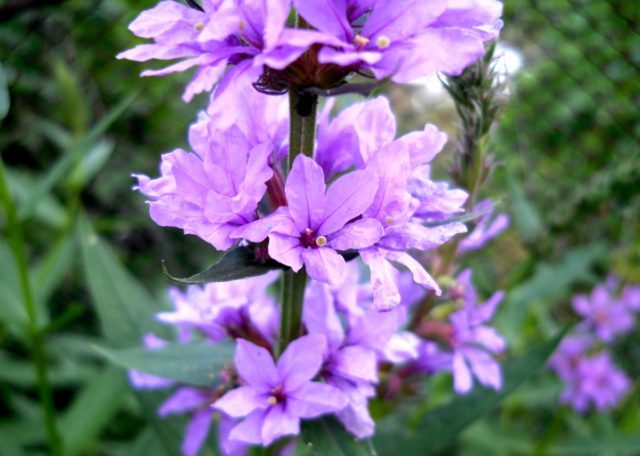
Coaster is an excellent honey plant; its sweet nectar has a transparent, amber color, a pleasant, tart taste, and an incomparable honey aroma.
Types and varieties of loosestrife with photos
Common loosestrife is characterized by the presence of more than 30 species with many varieties. Among their wide variety, willow and twig-shaped ones are most successfully used in landscape design.
Willow
Loosestrife (Lythrum salicaria) is a herbaceous perennial characterized by the following species characteristics:
- the root is woody, thick;
- stem straight, tetrahedral, branched;
- stem height up to 1 m;
- the number of shoots on one bush is up to 50;
- leaves are narrow, lanceolate, collected in 3 pieces in one whorl or opposite;
- leaf color is dark green;
- inflorescences are racemose, dense with small flowers, collected in whorls;
- flower diameter up to 1.5 cm;
- the color of the inflorescences is various shades of pink.
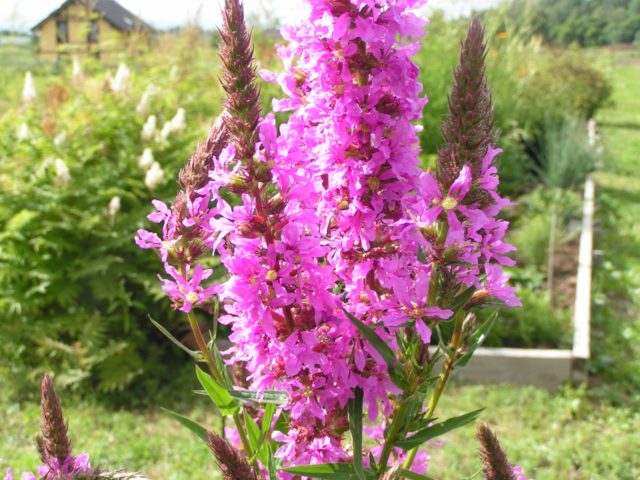
The willow leaf species is used in the design of the local area along with other ornamental plants
In the line of willow varieties one can distinguish such attractive specimens.
- The loosestrife variety Brighton is characterized by a pink-purple tone of the inflorescences.
Abundant flowering of the willow variety of weeding grass Brighton pleases the eye all summer, from June to September
- The loosestrife variety Roberte is distinguished by its coral-colored inflorescences. The variety is quite low-growing, the height of the stems and shoots reaches 60 cm.
The Roberts variety is deservedly considered one of the most attractive of the line of willow leaves due to the unusual, rare shade of the petals
- The loosestrife variety Roseum Superbum can be recognized by the bright pink color of the inflorescences.
Roseum Superboom is a delightful ornamental variety that looks ideal both in single plantings and next to other garden plants
- The loosestrife variety Pink pearl is a tall crop characterized by shoot heights of up to 1.2 m and pearl-pink color of the inflorescences.
Tall loosestrife bushes of the Pink Pearl variety are ideal for zoning a garden plot
- The loosestrife variety Rocket is a tall plant, the height of the stems reaches 1.5 m, the color of the flowers is burgundy.
The dark burgundy inflorescences of the willow variety Rocket noticeably rise above other representatives of the world of flora
- The loosestrife variety Feuerkerze is a profusely flowering, medium-sized crop characterized by shoot heights of up to 80 cm and pink-red inflorescences.
The medium-sized variety of weeping grass Feuerkertz blooms for 2 months
- The loosestrife variety Sticflamme is a spectacular representative of the species, which is characterized by large flowers of a bright purple hue.
The large-flowered variety Sticflamme looks good in single plantings
- The loosestrife variety Blush is a classic representative of the species, with a pink tint of numerous flowers.
The light pink coloring of the petals of Blush weeping grass is in perfect harmony with various stylistic trends in landscape design.
- The loosestrife variety Gypsy Blood (Zigeunerblut) is characterized by the bright red color of the inflorescences.
The willow variety Zigeunerblut is characterized by large flowers of a bright red hue.
Rod-shaped
The twig-like loosestrife in the garden (Lythrum virgatum) is represented by a diverse range of varieties, which are characterized by common characteristics:
- compact bush size;
- shoot height up to 1.2 cm;
- shoots are erect, branched;
- leaves are lanceolate, elongated;
- leaf color is dark green;
- racemose inflorescences;
- the color of the inflorescences is various shades of purple, dark pink.
The most popular representatives of the rod-shaped species:
- The variety of loosestrife Helen (Helen) is distinguished by the purple-pink color of its large inflorescences.
The height of the bushes of the low-growing variety of twig-shaped Helen is up to 50 cm
- The Rose Queen variety of loosestrife is characterized by the deep pink tone of individual flowers.
The Rose Queen variety is characterized by shoot heights with peduncles up to 70 cm
- The variety of loosestrife Modern Pink (Modern Pink) blooms with bright, lilac-pink buds.
Modern Pink - tall variety, shoot height reaches 1 m
- The variety of loosestrife Dropmore Purple is distinguished by a light pink tint of inflorescences.
Large-flowered, twig-like variety Dropmore Purple is great for single plantings
- The variety of loosestrife Modern Gleam can be recognized by the rich purple color of the inflorescences.
The packed racemes of Modern Gleam's twig-like cultivar combine elegantly with other flowering plants in the garden.
Merlin in landscape design
Among landscape designers, the perennial flower loosestrife is very popular due to its frost resistance, unpretentiousness of the crop to weather conditions and maintenance conditions. A tall ornamental plant has:
- beautiful, bright foliage;
- spectacular appearance and shape of inflorescences;
- magnificent color scheme;
- long flowering.
In the photo - loosestrife in landscape design:
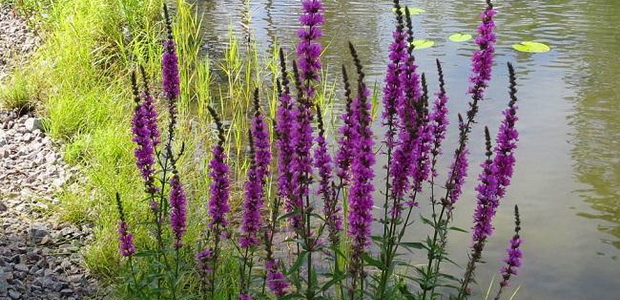
Various decorative varieties of perennial coastline look elegant and picturesque on the coastline of artificial or natural reservoirs
Decorative loosestrife harmonizes well with other moisture-loving “neighbors”: marsh gladioli, irises, astilbes, gunners, as well as phlox, lilies near artificial reservoirs or in a picturesque flood meadow.
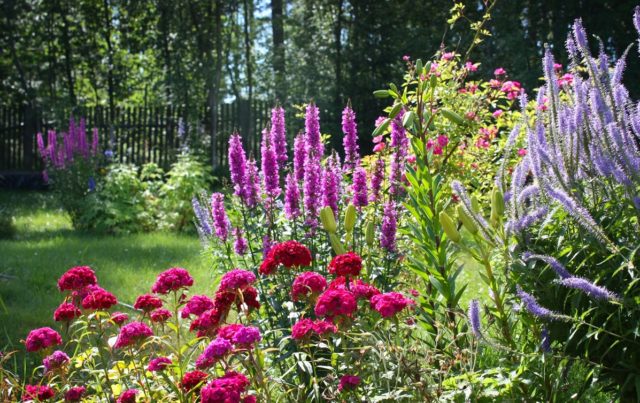
Merlin gets along well with brightly blooming peonies, phlox, lilies, and decorative garden carnations

Along with other tall crops, weeping grass can form an elegant composition in the style of a hedge
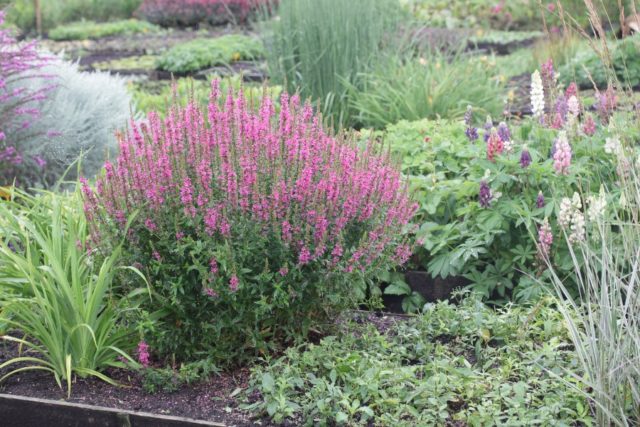
Plakun-grass - a beautiful accent on a prefabricated flower garden
When placing a crop in a garden bed, it should be taken into account that the root system of the perennial suppresses weaker plants.
How to propagate merlin
Perennial loosestrife can be propagated in the following ways:
- seed;
- vegetative (dividing the bush, cuttings).
Merlin seeds are propagated by seedlings, by direct sowing in open ground (suitable for southern regions with a mild climate) or by self-sowing.
The vegetative method of dividing the bush is used in autumn or spring. To divide the bush, choose a healthy, mature plant. 2-3 plots are made from the bush with the obligatory presence of a growing point. Transplanting loosestrife in the fall by dividing the rhizome is the best option, which allows young plants to grow stronger in winter.
Since the division of the woody root system is associated with some difficulties, the simplest vegetative propagation method is the cutting method. Root cuttings are selected with a growing point. Trimmed shoots are placed in nutrient soil and covered with glass or film to create a greenhouse effect. After the development of the root system, the seedlings are transferred to a permanent place.Reproduction of loosestrife by cuttings allows you to completely preserve the varietal characteristics of plants.
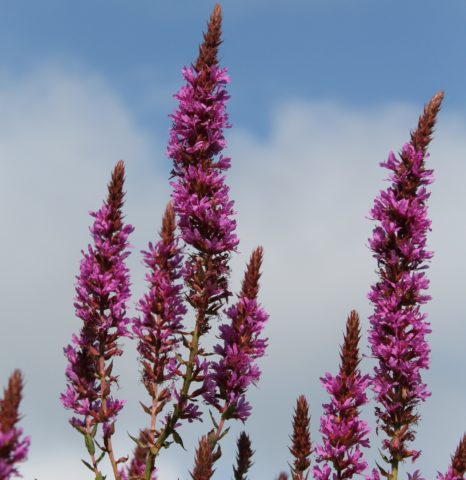
To guarantee the rooting of plots or seedlings of weeding grass, abundant watering should be provided until final establishment in a new place
Growing loosestrife seedlings from seeds
Planting loosestrife seeds for seedlings is done at home. Seed material is placed in disinfected containers with treated soil mixture in March. The soil chosen is nutritious and loose. Algorithm for sowing seeds for seedlings:
- seeds are distributed over the surface of the earth at a distance of up to 2 cm from each other;
- not buried;
- the crops are leveled with the palm of your hand and watered with a spray bottle;
- The container is covered with glass or plastic film.
To germinate loosestrife seedlings, the crops are placed in a cool place and grown at temperatures up to + 18 ⁰C. When three leaves appear, the sprouts dive.

Before moving into open ground, seedlings are hardened for 2 weeks
Planting and caring for loosestrife in open ground
Planting and caring for coastline in open ground is distinguished by a classic approach. The grown seedlings are transferred to a “permanent place of residence”, taking into account the basic preferences of the crop for the composition of the soil.
Recommended timing
Strong seedlings of perennial loosestrife, grown from seeds at home, are transplanted into open ground in May. The optimal transfer period is to establish a consistently warm air and soil temperature.
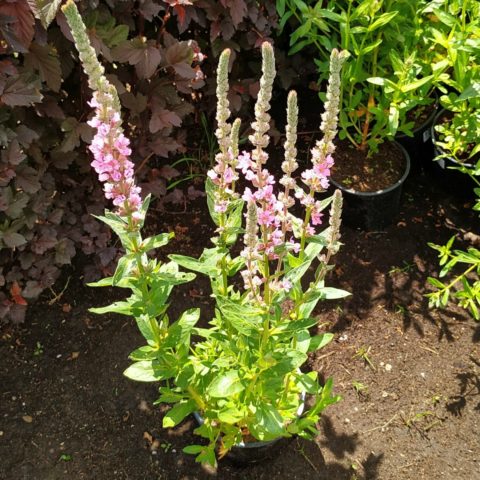
Sprouts of weeping grass are transferred to the ground when the threat of night spring frosts has passed
Site selection and preparation
To place decorative perennials in open ground, select garden areas near water bodies.Well-lit or slightly shaded corners of the garden are suitable for weeping grass.
The most preferable soils for garden crops are:
- wet;
- well drained;
- sour;
- with a high humus content.
Some landscape designers plant the crop in a pond to a depth of 30 cm.
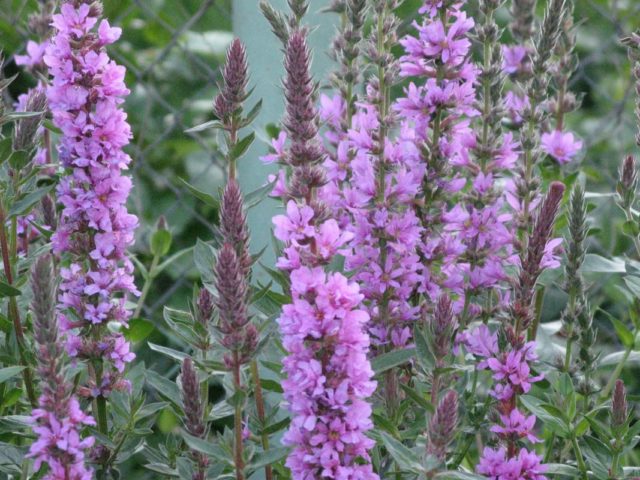
In case of strong shading, the plant will not please with abundant flowering
Where can you plant loosestrife next to?
Merlin is distinguished by a powerful, well-developed root system. When placing perennial bushes of any variety in the garden bed, it should be taken into account that it can suppress plants with less developed roots.
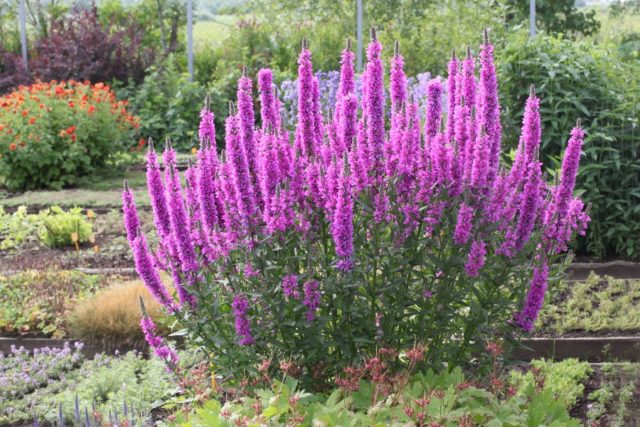
Ideal “neighbors” in the flower garden for weeping grass include tansy, lilies, phlox, and peonies.
Landing algorithm
Algorithm for planting loosestrife seedlings in open ground:
- formation of planting holes;
- application of organic fertilizers;
- moving seedlings into planting holes;
- abundant watering.
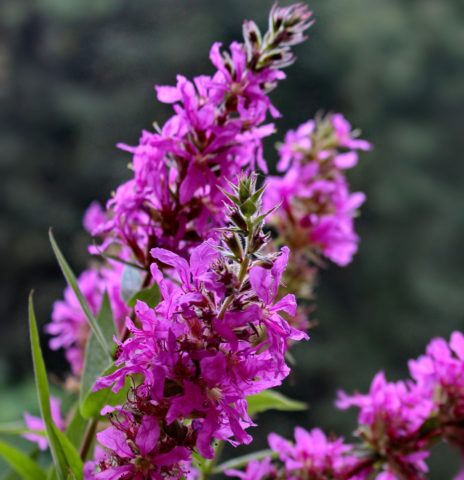
Seedling placement pattern - at least 40 cm from each other
Watering and fertilizing schedule
Gardeners who decide to plant a coastline in their garden should remember that the culture is exceptionally moisture-loving. The plant needs frequent watering:
- at least 1 time per week;
- at least 2-3 times a week when hot weather sets in.
For lush flowering, loosestrife needs sufficiently nutritious soil. Feeding is done as follows:
- You can mulch the soil around the loosestrife bushes with peat, compost or humus. This technique will not only maintain a sufficient level of natural moisture after watering, but also achieve a high nutrient content.
- Fertilizers with a low nitrogen content or any compositions for garden flowering crops can be fed to loosestrife bushes in June-July.
- In spring, you can add mineral complex fertilizers and sulfate nitrophoska to the soil.
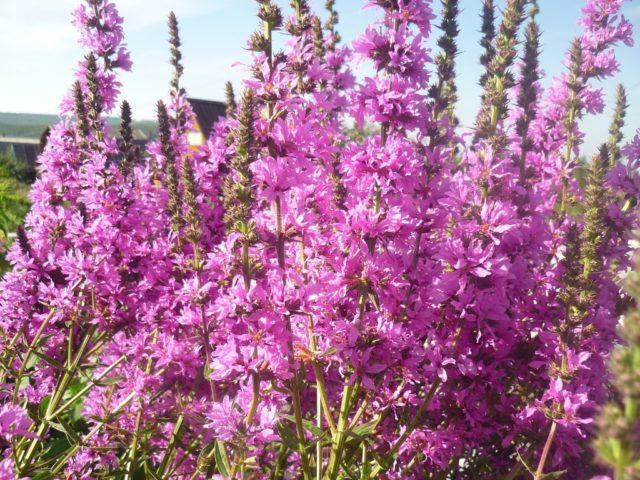
Before planting the crop, you can add a small amount of compost or humus to each hole.
Weeding, loosening, mulching
After watering, it is recommended to loosen the soil and remove weeds.
Mulching with mowed grass, peat, and straw allows you to effectively retain moisture around the bushes.

Weeping grass bushes will bloom more profusely if moisture is carefully retained after watering by mulching
Trimming
Pruning of ornamental loosestrife bushes is carried out in the spring. Side shoots that create an obstacle to fruitful formation must be removed.
Wintering
Garden boletus is a frost-resistant crop. For most regions of central Russia, the loosestrife does not need shelter.
In the fall, to ensure a more comfortable wintering, all stems and shoots are cut off at the root.
In areas with harsher conditions, the stems are not completely pruned at the root. The bushes are covered with dry leaves and sawdust.
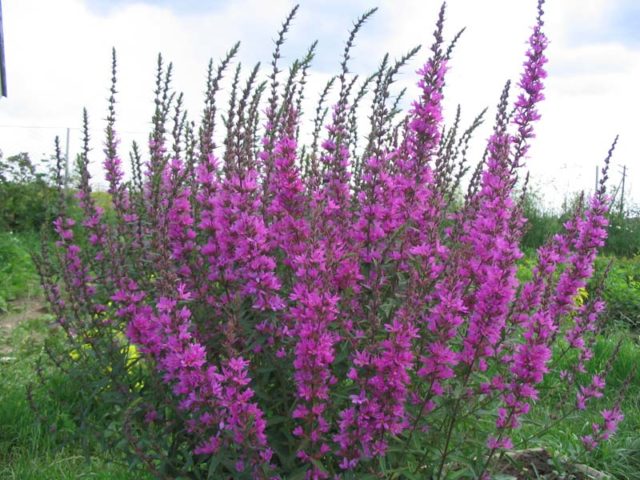
The remains of the shoots help retain snow, which effectively protects the root system from severe frosts.
Transfer
Once every 6-7 years, coastline bushes need to be transplanted and renewed. Manipulations are carried out in early spring or autumn. Adult mother bushes are completely dug out of the ground. Using a sharp garden tool, the root system is divided into 2-3 parts.
Each plot must be strong enough, contain viable growth points, developed roots and healthy shoots. The cut areas are sprinkled with wood ash.
The planting hole is formed in advance. Its size should correspond to the actual size of the plot.
The holes are fertilized with organic fertilizers (compost, manure, humus).
The plots are moved into holes, sprinkled with earth and pressed well.
The seedlings are watered abundantly and mulched with peat or organic matter.
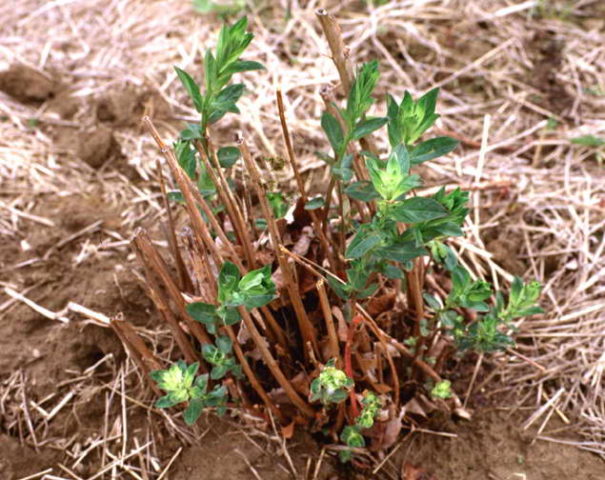
Transplanted plots bloom the next year, after rooting
Pests and diseases
Decorative coast plant has strong immunity to pathogens and pests. Experienced flower growers note rare cases of aphids infesting loosestrife bushes in close proximity to roses.
The insect sucks out the juices, which negatively affects the abundance of flowering and decorative appearance.
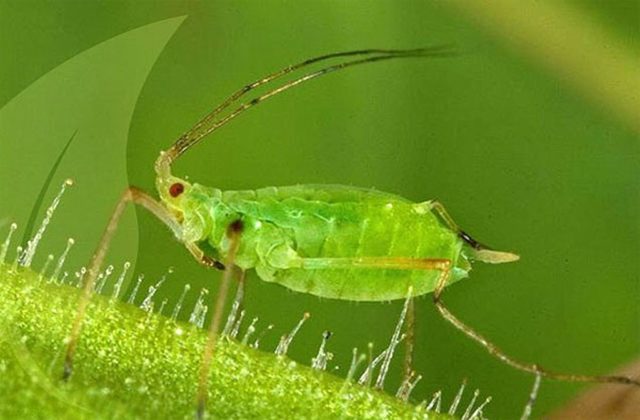
Affected plants are treated with insecticides
Conclusion
Planting and caring for loosestrife is simple and accessible to most gardeners and landscape designers. The majestic candles of the inflorescences of the decorative coast will fill the garden with rich shades of pink, lilac, burgundy, while observing simple requirements of agricultural technology.
